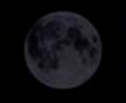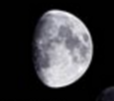![]()
![]()
![]()
Use LEFT and RIGHT arrow keys to navigate between flashcards;
Use UP and DOWN arrow keys to flip the card;
H to show hint;
A reads text to speech;
20 Cards in this Set
- Front
- Back
|
Section 1 |
Lunar Phases |
|

What moon phase is this? |
New moon. |
|

What moon phase is this? |
Waning crescent. |
|

What moon phase is this? |
Third quarter. |
|

What moon phase is this? |
Waning gibbous. |
|

What moon phase is this? |
Full moon. |
|

What moon phase is this? |
Waxing gibbous. |
|

What moon phase is this? |
First quarter. |
|

What moon phase is this? |
Waxing crescent. |
|
|
Section 2 |
Lunar Eclipses |
|
|
What is a lunar eclipse? |
An eclipse in where the moon appears darker as it passes the Earth's shadow. |
|
|
How does a lunar eclipse occur? |
A lunar eclipse occurs when the moon passes directly behind the Earth and they are exactly aligned. |
|
|
Section 3 |
Solar Eclipses |
|
|
What is a solar eclipse? |
An eclipse in where the sun is covered by the moon. |
|
|
How does a solar eclipse occur? |
A solar eclipse is occurred when the moon gets between Earth and the sun, and the moon creates a shadow over Earth. |
|
|
Section 5 |
Seasons |
|
|
What are the 4 seasons? |
Spring, summer, fall, and winter. |
|
|
How are seasons formed? |
The seasons are formed by the tilt of the Earth's rotational axis. |
|
|
Section 6 |
Relation between lunar phases and tides |
|
|
How do lunar phases affect tides? |
The gravitational force of the moon pulls the tides up but whenever the Moon, Earth and Sun are aligned, the gravitational force is much stronger which pulls its tides to its maximum tides. |

